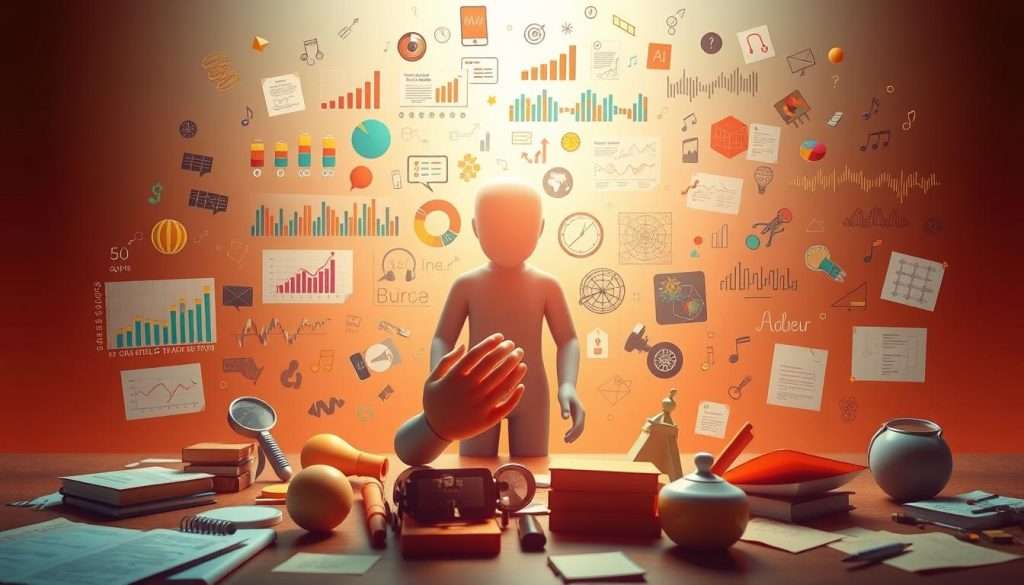Learning can be tough! But, there’s a way to make it easier. It starts with knowing how our brains handle information. When we encode information, we make it stick in our memory.
So, how do we do it right? Using effective learning techniques helps us remember better. In this article, we’ll dive into the science of encoding. We’ll also share tips to help you learn more effectively.
Key Takeaways
- Discover the importance of encoding in the learning process
- Learn effective techniques to improve information retention
- Understand how to apply encoding strategies in your daily study routine
- Boost your learning with practical tips and tricks
- Enhance your ability to recall information with confidence
Understanding the Science of Encoding in Learning
To really understand encoding, we must explore its science. Encoding moves information from our working memory to long-term memory. It’s key to learning.
What is Encoding and Why It Matters
Encoding is not just a simple process. It’s an active way to engage with what we’re learning. The levels of processing model (Craik & Lockhart, 1972) shows that deeper encoding leads to better retention. The deeper the encoding, the better the retention.
The Relationship Between Encoding and Memory Formation
Encoding is closely tied to memory formation. When we encode information well, it stays in our long-term memory. The quality of encoding directly impacts the strength of memory formation. This is why using encoding strategies is crucial for learners.
The Three Stages of Memory Processing
Memory processing has three stages: sensory memory, short-term memory, and long-term memory. Encoding is key in moving information from short-term to long-term memory. Here’s how these stages work together:
| Stage | Description | Role of Encoding |
|---|---|---|
| Sensory Memory | Initial processing of sensory information | Filtering relevant information |
| Short-Term Memory | Temporary holding of information | Rehearsal and initial encoding |
| Long-Term Memory | Permanent storage of information | Consolidation through deep encoding |
By grasping the science of encoding, we can create better learning strategies. This knowledge helps us control our learning, making it more effective and fun.
The Cognitive Foundations of Effective Encoding
Learning how our brains handle new information is key. When we get new data, our brains work hard to understand it.
How Your Brain Processes New Information
Our brains have a special way to deal with new stuff. First, our senses catch the info. Then, our brain sorts it out based on what’s important.
Working Memory vs. Long-Term Memory
It’s important to know the difference between working memory and long-term memory. Working memory is like a temporary desk for processing info. Long-term memory is where we keep things for a long time.
| Memory Type | Capacity | Duration |
|---|---|---|
| Working Memory | Limited (about 7 chunks) | Short-term (seconds to minutes) |
| Long-Term Memory | Large (potentially unlimited) | Long-term (hours to years) |
The Role of Attention in Successful Encoding
Attention is super important for learning. By focusing on what we want to learn, we remember it better.
Knowing how our brains work and using smart learning strategies can really help us learn and remember better.
Visual Encoding Techniques for Enhanced Retention
Visual encoding techniques can change how you learn and remember new stuff. It uses images, diagrams, and other visual tools to make info stick in your mind.
Mind maps and concept diagrams are great for organizing info. They help you see how things are connected. Start with a main idea and add related ideas around it. Use colors and symbols to mark key points.
Creating Mind Maps and Concept Diagrams
Mind maps are great for brainstorming and seeing how ideas connect. They help you grasp complex topics better and remember them longer.
Implementing Color-Coding Systems
Color-coding is a strong visual tool. It uses colors to sort and spot different types of info. This is super useful for studying or organizing notes.
Designing Personal Infographics and Visual Summaries
Infographics and visual summaries make info easy to see and remember. They mix text, images, and graphics in a way that’s fun and clear. This makes complex info easier to grasp and remember.
Using these visual techniques in your studies can really help you remember things better. It’s a great way to reach your learning goals.
Verbal and Acoustic Encoding Strategies
Let’s explore verbal and acoustic encoding strategies to boost your learning! Using our voices or listening to sounds helps a lot. It makes our memory and understanding better.
The Read-Recite-Review method is very effective. First, read the material. Then, say it out loud in your own words. Lastly, review it to make sure you understand it well. This way, you actively engage with the content, making it stick in your memory.
Practicing the Read-Recite-Review Method
To use this method, start by reading a part of your study material. Next, try to recall the main points without looking at the text. Finally, review the material again to fill in any gaps. This verbal encoding makes it easier to remember later.
Creating Audio Summaries of Complex Material
Creating audio summaries of hard information is another good strategy. Record yourself summarizing the key points in your own words. This method not only helps you understand and remember better. It also gives you a study tool you can listen to anytime, anywhere.
Developing Rhythmic and Musical Memory Techniques
Using rhythm and music is a fun way to encode information. Try setting important information to a tune or using a rhythmic pattern to remember lists or sequences. This acoustic encoding makes learning fun and helps information stick in your memory.
| Technique | Description | Benefits |
|---|---|---|
| Read-Recite-Review | Read material, recite it out loud, review | Active engagement, improved recall |
| Audio Summaries | Record summaries of key points | Portable, reinforces understanding |
| Rhythmic/Musical Encoding | Use tunes or rhythms to remember info | Engaging, aids memory |
By adding these verbal and acoustic encoding strategies to your study routine, you can learn more effectively. Try out different methods to see what works best for you!
Encoding in Learning: Making Meaningful Connections
When we learn new things, our brains look for connections. This makes it easier to remember later. Using good learning strategies can help make these connections stronger.
Applying Elaborative Interrogation Techniques
Elaborative interrogation is a great way to learn better. It means asking yourself questions like “Why is this important?” or “How does it relate to what I know?” This way, you’re not just reading; you’re really thinking about it.
For example, when learning a new historical date, think about how it ties to other events. This makes the information stick in your mind better.
Building Personal Analogies and Metaphors
Creating personal analogies and metaphors is another smart strategy. It helps make hard ideas easier to grasp by comparing them to things you know. For example, understanding computers can be like managing a library, where files are like books.
This method helps you understand and remember better. The more personal and vivid your analogy, the easier it is to recall.
Connecting New Information to Your Knowledge Base
It’s also key to link new info to what you already know. This means seeing how new ideas fit into your existing knowledge. For example, if learning a new language, connect its grammar to your native language’s rules.
This builds a network of knowledge that’s easy to use and remember. By using these strategies, you’re not just memorizing; you’re making learning meaningful and useful.
Multimodal Encoding: Combining Strategies for Maximum Impact
Learning is better when you use more than one sense. This is called multimodal encoding. It combines different ways to learn, making it more fun and effective.
Implementing Dual Coding in Your Study Routine
Dual coding pairs pictures with words to make learning richer. For example, watch a documentary on history and take notes. This way, your brain gets to process information in a more engaging way.
To use dual coding, add diagrams or videos to your notes. Try mixing different formats to keep your study sessions interesting.
Customizing Your Approach Using the VARK Model
The VARK model sorts learners into four types: Visual, Auditory, Reading/Writing, and Kinesthetic. Knowing your type helps you learn better. For example, kinesthetic learners might enjoy hands-on activities.

Find your learning style with a VARK questionnaire. Then, use study methods that fit your strengths. Visual learners might prefer diagrams and infographics.
Creating Multi-Sensory Learning Experiences
Multi-sensory learning uses many senses at once. It makes learning more fun and effective. For example, watch a video, listen to a podcast, and do a related activity.
Try different multi-sensory techniques to see what works best for you. Keep changing things up to keep your study sessions exciting.
Advanced Mnemonic Devices and Memory Systems
Ready to boost your learning? Let’s dive into advanced mnemonic devices that supercharge your memory. These tools make remembering complex info easy, making learning more efficient and effective.
Building and Using Your First Memory Palace
The memory palace, or method of loci, links memories to places. Start by picturing a familiar spot, like your home. Then, link the info you want to remember to specific spots in that place.
For example, to recall historical dates, link each date to a room in your house. The goal is to create vivid images that stick in your memory. With practice, you’ll remember info with great accuracy.
Creating Effective Acronyms and Acrostics
Acronyms and acrostics are simple yet powerful mnemonic tools. An acronym is a word from the first letters of a phrase. An acrostic is a sentence where the first letter of each word spells out the info you’re trying to remember.
For instance, “ROY G BIV” helps you remember the rainbow colors: Red, Orange, Yellow, Green, Blue, Indigo, Violet. You can make your own acronyms and acrostics to fit your learning needs.
Mastering Chunking for Complex Information
Chunking breaks down complex info into smaller parts. It’s great for long numbers or complex concepts.
For example, breaking a phone number into smaller groups makes it easier to remember. You can use chunking for other learning areas, like breaking down big topics into smaller parts.
| Mnemonic Device | Description | Example |
|---|---|---|
| Memory Palace | Associating memories with specific locations | Visualizing historical events in different rooms of your house |
| Acronyms | Forming words from initial letters | Using “ROY G BIV” to remember the colors of the rainbow |
| Chunking | Breaking down complex information into smaller chunks | Breaking down a phone number into smaller groups of numbers |
Measuring Progress and Troubleshooting Encoding Challenges
When you start using different encoding methods, it’s key to track your progress and solve any problems. You must figure out what works and what doesn’t. This helps you improve and reach your learning targets.
Testing Retention with Spaced Retrieval Practice
Spaced retrieval practice is a great way to check how well you remember things. It means reviewing material at longer and longer times to make it stick in your memory. By testing yourself often, you can see where you need to work harder.

Identifying and Overcoming Encoding Obstacles
Even with the best plans, you might hit roadblocks in encoding. Issues like information overload, lack of focus, and ineffective strategy use can pop up. To get past these, you need to find out why they’re happening and change your plan.
Adjusting Strategies Based on Performance Feedback
Performance feedback is vital for making your encoding methods better. By checking how well you’re doing and tweaking your approach, you can learn more effectively. You might switch to a different method, like moving from seeing to hearing information, or mix different techniques for better results.
Keep measuring your progress, spotting areas to get better, and tweaking your methods. This way, you can beat common encoding problems and meet your learning goals.
Conclusion: Transforming Your Learning Through Effective Encoding
We’ve looked at many ways to improve your learning, like using pictures and words, and even combining them. These methods help you remember things better and make connections.
Learning isn’t just about remembering stuff. It’s about changing how you take in and deal with new info. Using tools like mind maps and memory palaces can really change how you learn.
Now, it’s your turn to try these methods out. See which ones work best for you. You’ll likely find that you can learn and remember more easily. This change can make learning fun and more effective for you.

